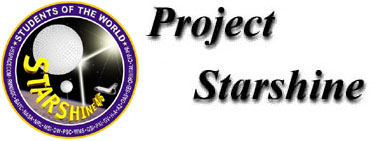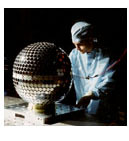

Michael A. Savell.
 
|
John Vasquez of the Naval Research
Laboratory prepares Starshine 1 for
vibration test. Photo by Michael A. Savell. |
|
Click Here: Project Description
STARSHINE 4/5 UPDATE - MAY 13, 2002
|
|
To view a list of the schools and other groups that requested and received
Starshine 4 mirror polishing kits, click here. You can also see which of them
returned their mirrors to us. If your school or other group returned
mirrors to Starshine Project headquarters, but you do not see its name or
mirror return date listed here, please send the name and address of your
group and details about your shipment to gilmoore12@aol.com.
Dr. Alan Shapiro of the Space Optics and Manufacturing Center of the Marshall Space Flight Center has finished applying a protective coating of silicon dioxide to nearly all the mirrors for the Starshine 4/5 mission. This coating will protect the surface of your mirrors from becoming converted into aluminum oxide by atomic oxygen that exists at the altitudes at which the Starshine satellites orbit the earth. Aluminum is 10 per cent more reflective than aluminum oxide in visible light, and we need all the help we can get to make your tiny mirrors reflect enough sunlight to be seen at a distance of up to 1000 miles (1600 km) in the twilight sky. The other purpose of this coating is to protect the surfaces of your mirrors while we're handling them in the mirror installation and satellite testing processes. |
|
NASA Marshall
optical physicist Vince Huegele is shown displaying all the Starshine 4
mirrors processed to date in this image taken by NASA "resident photographer
extraordinaire" Emmitt Given. By the way,
before the Marshall physicists apply the silicon dioxide coating to your
polished mirrors, they have to do a lot of painstaking preparatory work that
takes far too much space to explain here. If you're interested in the
details, send an email message to Vinson.Huegele@msfc.nasa.gov and ask him to
spell them out for you.
Over the past couple of years, Vince has measured the average reflectivity of a statistically representative sample of student-polished mirrors for the Starshine 3 and Starshine 4 missions. Here is what he had to say today about the improvement he has seen in your mirrrors for the Starshine 4 mission: "The average reflectivity of a sampling of Starshine 4 mirrors that we just finished coating is 87.8%, with the lowest reading of 75% and a high of 90%. The average value for Starshine 3 mirrors was 72.6 %. |

|
| I could continue to measure more SS4 mirrors, but their variation in quality is nowhere near the spread of Starshine 3, so I believe the average I have now will represent the whole batch." That is high praise, indeed, from an expert in the space optics field. It shows that you have achieved a fifteen percent increase in average mirror reflectivity from one mission to the next. Wow! Way to go, students and teachers! |
|
All these data will be
combined to determine the orbit of Starshine 4. On the other hand, Starshine 5
will have no mirrors and will thus not be naked-eye visible, so we will depend
totally on
ISLR and Space Command tracking for orbit determination of this satellite.
By comparing the orbital decay rates of Starshines 4 and 5, it will possible for us
to determine the density of the earth's atmosphere more precisely than we've been
able to do on previous missions.
Here is a sketch of where the Hitchhiker canister containing Starshines 4 and 5 will be
located in Atlantis' cargo bay on the STS-114 mission.  Click here for a larger version
We recently held a Starshine 4/5 technical interchange meeting at the NASA Goddard
Space Flight Center. As you can see from the expressions on the faces of safety
engineer Butler Smythe of SRS, Starshine engineers John Vasquez and Bill Braun
of the Naval Research Laboratory and Tom Dixon, Goddard's Phoenix Mission Manager
(the gentleman holding the Starshine 5 prototype), the meeting went well.

 Click Here for 300 DPI version To order a cloth patch of this logo, contact Stephen Myers at svm@cisco.com. |
Return to Project Starshine Home Page
Last Updated: May 13, 2002